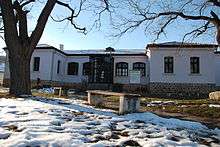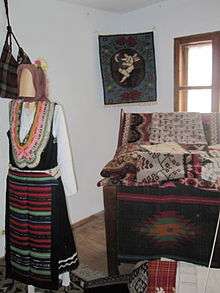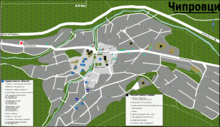Chiprovtsi
Get in
There are daily buses departing at 18:00 from the Central Bus Station in Sofia. As of March 2011, a one-way ticket costs 14 leva. The trip takes approximately 3 hours, the center of Chiprovtsi being the last stop on the route.
Buses depart from the Montana bus station at 10:20, 12:30 (M-F only), 15:40, 17:40, and 20:20. The ticket costs 3.50 leva, and the journey takes approximately 45 minutes. The majority of these buses are labeled to Martinovo (Мартиново), the final route destination.
Buses depart from Chiprovtsi to Montana at 6:40, 10:00, 12:20 (Chiprovtsi Express to Sofia), and 16:50. The ticket costs 3.50 leva, and the journey takes approximately 45 minutes. Bus and train connections can be made to all the major cities in Bulgaria from Montana.
See

- Chiprovtsi Historical Museum, 2, ulitsa Vitosha (The museum is normally locked, and one must go to the administrative offices located to the left of the museum and ring the bell for assistance.), ☎ +359 95-542 168. Daily 8:00-17:00 (Sa from 09:00). The museum was founded in 1988 on the anniversary of the Chiprovtsi Uprising. The main exhibition is housed in a renovated schoolhouse, built in 1866 by monks from the Chiprovtsi Monastery. English translations are provided for each of the exhibitions. 2 lev for adults and 0.50 lev for children. Guided tours are available for 2 leva..

- Ethnographic Museum “Katerina Kushta”. The Ethnographic Museum is at the foot of the hill below the Historical Museum and faces the river. Inquire at the Historical Museum for access and a tour. On the second floor, rooms are set up with to display the way of life and culture of the Torlatsi: a traditionally dressed wedding party, a kitchen and living room, and a traditional bedroom with desk. Make sure to look at the old order book with swatches of wool dyes and their description in several languages from the early 1900s. In the garden are traditional plants used for dying fabric, and a display case with the colors they create is found to the right of the stairs. The office on the first floor also has a small selection of books and souvenirs for sale.
- Sankta Maria Catholic Church. Chiprovtsi is proud of its Orthodox and Catholic heritage, and the close proximity of this church and Vaznesenie Hristov Orthodox Church serve as an example of the harmonious coexistence of the town’s Saxon and Slavic history. The Sankta Maria Catholic Church was built in 1371 and was a center of Bulgarian Catholicism prior to the 1688 uprising.
- Vaznesenie Hristov Orthodox Church. It is not known exactly when the Vaznesenie Hristovo Orthodox Church was constructed, but it was before 1688. During the uprising it was severely damaged, but later restored. Today, it is an operative shrine and serves as a significant architectural and cultural monument.
- St. Nikolai Church. St. Nikolai Church is a bit difficult to find and not as well marked, but certainly worth seeing if you have the time. It was built in the 17th century, but only the foundations and part of the apse of this church remain. The ruins can be found 20 meters east of Sharena Cheshma. At the fountain, walk behind the building with the small convenience store. The building should be on your left, the fountain on your right. At the back of the building, turn left and follow the dirt path for 15 m. St. Nikolai will be on your right.
- . Sharena Cheshma (literally means ‘Colorful Fountain’) is an ancient covered fountain with stone frame and seats. A small structure provides protection from the elements for those waiting to fill water from the mineral springs below. Sharena Cheshma is one of few surviving Roman architectural ruins in Northwest Bulgaria. Undamaged by the Russo-Turkish War of 1877, Sharena Cheshma has been a central gathering place for residents of the region since Roman times, except for a brief period following the Chiprovtsi Uprising of 1688. Many residents still prefer to retrieve drinking water from the fountain over tap water.
- Stone Crosses. While walking around Chiprovtsi, keep an eye out for the ancient looking stone crosses scattered seemingly at random around town. Their significance, originating in pagan times, extends to modern day Christian rituals. In the past, sacrifices in honor of the god/patron of a certain area were carried out in perceived holy places – under big trees, on tops of hills, etc. Some of these places were preserved and the superstitions connected with them have been preserved over the years. Gradually the ritual trees were replaced with stone crosses, each cross representing a different saint. On the day of the saint, a lamb is sacrificed, blessings are made, and a ceremonial table is laid. Each family brings a ritual loaf of bread with a beeswax candle lit in the center. These celebrations are connected with the belief in that patron saints will protect believers from natural calamities. A spectacular celebration on top of a mountain occurs at the stone cross at the Gushovski Monastery on September 6th for St Michael the Archangel. Celebrations at the other crosses and their dates: January 6 – St. Jordan Day and Epiphany, May 9 - St. Nicholas Summer, 5 June - Ascension Day, Date varies – St. Trinity, June 29 - Holy Apostles Peter and Paul, July 20 - St. Elias, August 6 - Transfiguration, August 15 - Assumption of Mary, September 6 –St. Michael the Archangel, and October 26 – St. Dimitir.
- St. Ivan of Rila Chiprovski Monastery. The Chiprovtsi Monastery has had a turbulent history: It was founded in the 10th century during the First Bulgarian State, but has been destroyed and rebuilt six times since: in 1412, 1688, 1806, 1828, 1837 and 1876. Most of the current structure dates from 1829. The complex includes the a stone bell-tower with an ossuary, and a small chapel, buildings with chardatsi (terraces) and wooden arches, and a cemetery. A wooden gazebo marks the turn off for the Chiprovtsi Monastery, which is located about 6 km away from Chiprovtsi towards Montana. It is a working monastery with one priest in residence. He is welcoming to guests; and the fantastic view from the stone bell-tower, the ossuary of victims of the 1688 uprising, the and beautiful wood carved icons in the church of St. Ivan of Rila are not to be missed. Monasteries are self-sufficient on the gardens and animals kept by the priest, but purchasing a few beeswax candles to light at an altar are greatly appreciated.
- Gushovski Monastery. The Gushovski Monastery was built in the 17th century and destroyed during the 1688 Chiprovtsi Uprising. Two stone crosses are located here: one at the top of the mountain, another by the altar in the base of the old stone church ruins. Near the ruins, rows of traditional stone hearths for bread making, a stone fountain for with drinking water, picnic tables, and other things have been built for visitors. It can be reached by foot or by car and is the halfway point between Chiprovtsi and the Chiprovtsi Waterfall along the Eco Trail “Deyanitsa.”
Buy
Eat
Drink
Sleep
Connect
Tourist Information Center
Recently relocated to the first floor of the Cultural Center, the Tourist Information Center is open Tuesday-Saturday from 10-5 (closed from 12-1 for lunch). Here you can find pictures of Chiprovtsi, information brochures for Bulgaria, and a wide selection of carpets on display. The helpful staff will answer any questions, but be ready to speak in Bulgarian or ask for someone who speaks English.
1st Floor Peter Bogdan Cultural Center [Chitalishte] Peter Parchevich Street No. 57 Telephone: 00359 (0) 9554 0888763843

Go next